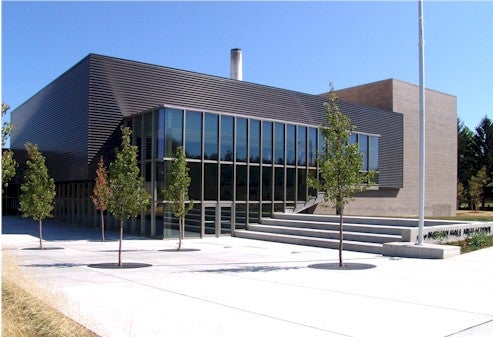About
About Nathan Hale High School

The Nathan Hale High School curriculum offers students a balanced educational experience focusing upon developing critical thinking and communication skills so that our students become members of a responsible, democratic citizenry.
Our school is nationally recognized as a leader in school reform efforts that result in providing a rigorous and relevant education for our young adults that is intentional, integrated, and collaborative in nature.
Students will graduate with the greatest number of opportunities open to them. Honors, Advanced Placement, and modified transcript designations are awarded for work in our full-inclusion classrooms and are available across the curriculum.
We are proud of the number of students who participate in NHHS sports, clubs, music and theatre. Our C-89.5 radio station is nationally ranked and sets national trends.
Student voice is valued and encouraged. Students serve on our Principal’s Advisory Committee, our Race and Equity Team and on Senate, our building leadership team. Student led forums are attended by students and staff alike.
Nathan Hale enjoys exceptional parent and community support for our academic programs, activities, and athletics through the Nathan Hale Community Organization, booster clubs, and the Nathan Hale High School Foundation.
Nathan Hale High School has a building culture of shared leadership, demonstration of mastery, critical-thinking, and values in-depth study, creativity and reflection. Trust, respect, decency, and equity throughout the school community are hallmarks of our building culture.
Nathan Hale HS Celebrates 50th Anniversary of Japan Student Exchange
Connecting Cultures March 5, 2025
Nathan Hale High School hosted a special ceremony to commemorate the 50th anniversary of its student exchange program with Naha Senior High School in Okinawa, Japan. The event celebrated five decades of cross-cultural friendships, educational growth, and international understanding between the two cities. Students from Nathan Hale’s Native Club welcomed visitors and special guests by singing a native welcome song. Seattle Mayor Bruce Harrell spoke about his own Japanese heritage. The Japanese Consul General Makoto Iyori and Superintendent Brent Jones also attended and gave speeches commemorating the milestone.
Since 1975, this unique student exchange has shaped generations of students and teachers, creating friendships that span continents and lifetimes. Initiated just three years after Okinawa’s historic return to Japan in 1972, the program stands as a powerful symbol of reconciliation, cultural immersion, and the shared human experience beyond borders. Read entire article on the district website.
We are The Raiders!
Named after Nathan Hale, the American Patriot during the Revolutionary War, our school colors are Red, White, and Blue.
Our Mission, Values, Principles
The purpose of Nathan Hale High School is to ensure that ALL students will become honorable, skillful, thinking, global citizens.
Core Values
- We expect that teaching is the essential act of all adults at school
- We promote a climate of respect, trust and decency
- We expect all members to understand, model and promote social justice
- We believe that all students – wherever they are as learners will meet high standards
- We value in-depth study, critical thinking, creativity, and reflection…we believe our students learn by doing
- We empower our students and our families in the learning process
- We value a personal caring relationship with each student
- We commit ourselves to those students who historically have not been successful
- We expect that all discipline be firm, fair, positive and consistent
As a Learning Community We…
- Value a personal caring relationship with each student
- Value in-depth study, critical thinking, creativity and reflection, believing our students learn by doing
- Believe that all students-wherever they are as learners-will meet high standards
- Expect that teaching is the essential act of all adults at school
- Expect all members to understand, model and promote social justice
- Promote a climate of respect, trust, and decency
- Expect that all discipline be firm, fair, positive, and consistent
- Empower students and their families in the learning process
- Commit ourselves to those students who historically have not been successful
Nathan Hale inspired by Coalition of Essential Schools (CES) principles
Coalition of Essential Schools (CES)
Nathan Hale is inspired by the Coalition of Essential Schools and provides personalization in education in a rigorous inclusive environment. The Ten Common Principles of the Coalition of Essential Schools guide the vision for Nathan Hale.
- Learning to use one’s mind well: The school should focus on helping young people learn to use their minds well. Schools should not be comprehensive if such a claim is made at the expense of the school’s central intellectual purpose.
- Less is more, depth over coverage: The school’s goals should be simple so that each student master a limited number of essential skills and areas of knowledge. While these skills and areas will, to varying degrees, reflect the traditional academic disciplines, the program’s design should be shaped by the intellectual and imaginative powers and competencies that the students need, rather than by “subjects” as conventionally defined. The aphorism “less is more” should dominate: curricular decisions should be guided by the aim of thorough student mastery and achievement rather than by an effort to merely cover content.
- The school’s goals should apply to all students, while the means to these goals will vary as those students themselves vary. School practice should be tailor-made to meet the needs of every group or class of students.
- Personalization: Teaching and learning should be personalized to the maximum feasible extent. Efforts should be directed toward a goal that no teacher have direct responsibility for more than 80 students in the high school and middle school and no more than 20 in the elementary school. To capitalize on this personalization, decisions about the details of the course of study, the use of students’ and teachers’ time and the choice of teaching materials and specific pedagogies must be unreservedly placed in the hands of the principal and staff.
- Student as worker, teacher as coach: The governing practical metaphor of the school should be student-as-worker, rather than the more familiar metaphor of teacher-as-deliverer-of-instructional-services. Accordingly, a prominent pedagogy will be coaching, to provoke students to learn how to learn and thus to teach themselves.
- Demonstration of mastery: Teaching and learning should be documented and assessed with tools based on student performance of real tasks. Students not yet at appropriate levels of competence should be provided intensive support and resources to assist them quickly to meet those standards. Multiple forms of evidence, ranging from ongoing observation of the learner to completion of specific projects, should be used to better understand the learner’s strengths and needs, and to plan for further assistance. Students should have opportunities to exhibit their expertise before family and community. The diploma should be awarded upon a successful final demonstration of mastery for graduation – an “Exhibition.” As the diploma is award when earned, the school’s program proceeds with no strict age grading and with no system of credits earned by “time spent” in class. The emphasis on the students’ demonstration that they can do important things.
- A tone of decency and trust: The tone of the school should explicitly and self-consciously stress values of un-anxious expectation (“I won’t threaten you but I expect much of you”), of trust (until abused) and of decency (the values of fairness, generosity, and tolerance). Incentives appropriate to the school’s particular students and teachers should be emphasized. Parents should be key collaborators and vital members of the school community.
- Commitment to entire school: The principal and teachers should perceive themselves as generalists first (teachers and scholars in general education) and specialists second (experts in but one particular discipline). Staff should expect multiple obligations (teacher- counselor-manager) and a sense of commitment to the entire school.
- Resources dedicated to teaching and learning: Ultimate administrative and budget targets should include, in addition to total student loads per teacher of 80 or fewer pupils on the high school and middle school levels and 20 or fewer on the elementary level substantial time for collective planning by teachers, competitive salaries for staff, and an ultimate per pupil cost not to exceed that at traditional schools by more than 10 percent. To accomplish this, administrative plans may have to show the phased reduction or elimination of some services now provided students in many traditional schools.
- Democracy and equity: The school should demonstrate non-discriminatory and inclusive policies, practices, and pedagogies. It should model democratic practices that involve all who are directly affected by the school. The school should honor diversity and build on the strength of its communities, deliberately and explicitly challenging all forms of inequity.
Five Habits of Mind
Students at Nathan Hale High School develop critical thinking skills and engage with topics by learning and using the Five Habits of Mind. Students are expected to critically view material retrieved from various sources. They are taught to question:
- Viewpoint – From whose viewpoint are we seeing, reading or hearing? From what angle or perspective?
- Evidence – How do we know what we know? What’s the evidence and how reliable is it?
- Relevance – What does it matter? What does it all mean? So what?
- Connections – How are things, events or people connected to each other? What is the cause? What is the effect? How do they “fit” together?
- Supposition – What if…? Could things be otherwise? What are or were the alternatives?
Contact Us
Administrators
Jolene Grimes Edwards
Principal; jmgrimes@seattleschools.org
Ambyr Burrell
Assistant Principal; alburrell@seattleschools.org
Kirsten Zoba
Assistant Principal; kizoba@seattleschools.org
Main Office Staff
Rae Keyes, Administrative Secretary: rkkeyes@seattleschools.org 206-252-3680.
- Ask questions if you don’t see the information elsewhere and you will be directed to the right person.
- Leave message for principal or assistant principals.
Courtney Clark, Assistant Secretary: ccclark@seattleschools.org
- Ask your questions about athletics and athletics paperwork.
- Questions about the Daily Bulletin can be directed here.
Attendance Office
Report absence, late arrival or early departure. Prints up student attendance report
Martha Cunningham-Daniels: 206-252-3684 or email: halehs.attendance@seattleschools.org
Registrar
Registration, transcripts and academic history
Maria Gutierrez: mjgutierrez@seattleschools.org 206-252-3699
Fiscal Office
Class & ASB fees, purchasing yearbook, outstanding fines
Emily Wong: eywong@seattleschools.org 206-252-3753
Counseling Secretary
Make appointment with your student’s counselor
Francine Cunningham: frcunningham@seattleschools.org 206-252-3694
Nurse
Health concerns, medications taken while at school
Jenna Buller Nofziger: jmbullernofz@seattleschools.org 206-252-3687
Custodian
Building maintenance and student lockers
Ky Nguyen: kqnguyen@seattleschools.org 206-252-3750

